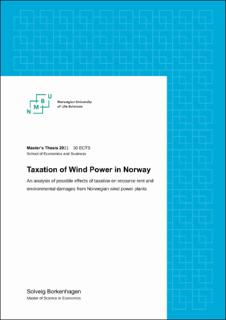| dc.contributor.advisor | Rosendahl, Knut Einar | |
| dc.contributor.advisor | Hagem, Cathrine | |
| dc.contributor.author | Borkenhagen, Solveig | |
| dc.coverage.spatial | Norway | en_US |
| dc.date.accessioned | 2021-08-09T10:30:46Z | |
| dc.date.available | 2021-08-09T10:30:46Z | |
| dc.date.issued | 2021 | |
| dc.identifier.uri | https://hdl.handle.net/11250/2766974 | |
| dc.description.abstract | Wind power production in Norway has increased rapidly over the past decades, and so has the associated discussions related to nature conservation. The dilemmas are substantial, with the growing need of renewable energy, but also a desire to protect pristine nature and wildlife. Today, there is little profitability related to the industry, but with future expectations of both lower cost and higher electricity prices, profitability may increase, i.e., there may be a significant resource rent from wind power production. Based on the encroachment and possible resource rent, both resource rent taxation and environmental taxation may be relevant to consider for Norwegian wind power. A tax on the resource rent is already used for other nature resources in Norway. Environmental taxation related to nature encroachment is not used in Norway, but it has been proposed for several industries. An environmental tax aims to achieve a more efficient level of production and spatial allocation of wind power plants. This paper analyses potential effects of these two tax schemes for wind power in Norway. The analysis uses detailed information about projects holding a license with their respective costs and two scenarios for future electricity prices.
The resource rent tax scheme for hydro power is used as a base, with a tax rate at 37%. With the data set used, a total annual resource rent at 170 million NOK would be generated in the base scenario with production at 3.4 TWh. In the high-price scenario, the annual resource rent would increase to 513 million NOK with production at 8.2 TWh. The environmental tax is divided into a CO2 tax and an encroachment tax. If a CO2 tax on emissions is introduced alone, it does not change the total amount of power produced, but it will reduce the profitability for several of the projects. With total environmental taxation, CO2 and encroachment tax, the production is reduced with 35% and 38% in the base and high-price scenario, respectively. After introduction of environmental taxation, the resource rent is reduced by about 35% in both scenarios. If a resource rent tax is combined with environmental taxation, the resource rent tax income would be reduced, but the total effect is increased tax income, compared to a situation with only resource rent taxation.
The recommendations to draw from this analysis is to work towards environmental taxation on wind power in Norway. For this to be possible, more research is necessary, especially related to valuation and damages from production. A CO2 tax could be considered as a first step towards full environmental taxation. Further, the resource rent from production should be followed closely, and a tax on this should be introduced when the resource rent gets substantial. | en_US |
| dc.description.abstract | Vindkraft har økt kraftig i Norge over de siste tiårene, og det har også den tilhørende debatten knyttet til naturvern. Dilemmaene er betydelige, med økende behov for fornybar energi, men også et ønske om å verne uberørt natur og dyreliv. I dag er det lite lønnsomhet knyttet til industrien, men med fremtidige forventninger om både lavere kostnader og høyere kraftpriser kan lønnsomheten øke og det kan bli en betydelig grunnrente knyttet til vindkraftproduksjon. Basert på naturinngrepene og grunnrenten, kan både grunnrenteskatt og naturavgift være relevant å vurdere for norsk vindkraft. En skatt på grunnrente er allerede brukt for andre naturressurser i Norge. Naturavgift relatert til naturinngrep er ikke brukt i Norge i dag, men det har blitt foreslått for flere sektorer. En naturavgift sikter på å oppnå et mer effektivt produksjonsnivå og allokering av vindkraftverk. Denne oppgaven analyserer potensielle effekter av disse to skattesystemene for vindkraft i Norge. Analysen bruker detaljert informasjon om prosjekter som har fått lisens med tilhørende kostnader og to scenarioer for fremtidig kraftpris.
Grunnrenteskatten for vannkraft er brukt som et utgangspunkt, med en skattesats på 37%. Med dataen som er brukt her, vil det genereres en årlig grunnrente på 170 millioner NOK i et basisscenario med produksjon på 3,4 TWh. I et høyprisscenario vil grunnrenten øke til 513 million NOK med en produksjon på 8,2 TWh. Naturavgiften er delt inn i en CO2-avgift og en avgift på naturinngrep. Dersom CO2-avgiften er introdusert alene vil ikke produksjonsnivået endre seg, men dette vil redusere lønnsomheten for flere av prosjektene. Med en total naturavgift, CO2 og naturinngrep, vil produksjonen reduseres med henholdsvis 35% og 38% i basis- og høyprisscenarioet. Etter introduksjonen av naturavgiften vil grunnrenten reduseres med omtrent 35% i begge scenarioene. Dersom en grunnrenteskatt er kombinert med naturavgiften vil grunnrenteskatten reduseres, men totaleffekten er økt skatteinntekt sammenliknet med en situasjon med kun grunnrenteskatt.
Anbefalinger som kan trekkes fra denne analysen er å jobbe mot en naturavgift på vindkraft i Norge. For at dette skal bli mulig er det nødvendig med mer forskning, spesielt relatert til verdsetting og ødeleggelser fra produksjonen. En CO2-avgift kan vurderes som et første steg i retning av en fullstendig naturavgift. Videre så bør grunnrenten fra produksjonen observeres tett, og en skatt på dette bør introduseres når grunnrenten blir betydelig. | en_US |
| dc.language.iso | eng | en_US |
| dc.publisher | Norwegian University of Life Sciences, Ås | en_US |
| dc.rights | Attribution-NonCommercial-NoDerivatives 4.0 Internasjonal | * |
| dc.rights.uri | http://creativecommons.org/licenses/by-nc-nd/4.0/deed.no | * |
| dc.title | Taxation of wind power in Norway : an analysis of possible effects of taxation on resource rent and environmental damages from Norwegian wind power plants | en_US |
| dc.type | Master thesis | en_US |
| dc.description.localcode | M-ECON | en_US |

